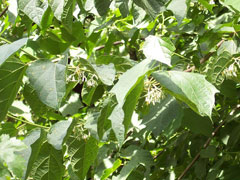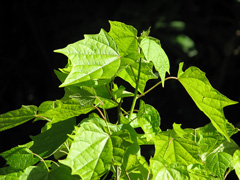 |
|
http://commons.wikimedia.org/wiki/User:Cillas |
 |
| flickr.com/photos/peganum/ |
Translate this page:
Summary
Bloom Color: White. Bloom Time: Late Spring/Early Summer Mid Summer. Foliage: Grown for foliage
Physical Characteristics

 Alangium platanifolium is a deciduous Shrub growing to 3 m (9ft) by 2 m (6ft).
Alangium platanifolium is a deciduous Shrub growing to 3 m (9ft) by 2 m (6ft).
See above for USDA hardiness. It is hardy to UK zone 8. It is in flower from June to July. The species is hermaphrodite (has both male and female organs).
Suitable for: light (sandy), medium (loamy) and heavy (clay) soils and prefers well-drained soil. Suitable pH: mildly acid, neutral and basic (mildly alkaline) soils. It cannot grow in the shade. It prefers moist soil.
UK Hardiness Map
US Hardiness Map
Synonyms
Marlea platanifolium.
Plant Habitats
Woodland Garden Dappled Shade;
Edible Uses
Edible Parts: Leaves
Edible Uses:
Young leaves - cooked[177].
References More on Edible Uses
Medicinal Uses
Plants For A Future can not take any responsibility for any adverse effects from the use of plants. Always seek advice from a professional before using a plant medicinally.
Antirheumatic
The root is used in the treatment of rheumatism and other bone diseases[218].
References More on Medicinal Uses
The Bookshop: Edible Plant Books
Our Latest books on Perennial Plants For Food Forests and Permaculture Gardens in paperback or digital formats.

Edible Tropical Plants
Food Forest Plants for Hotter Conditions: 250+ Plants For Tropical Food Forests & Permaculture Gardens.
More

Edible Temperate Plants
Plants for Your Food Forest: 500 Plants for Temperate Food Forests & Permaculture Gardens.
More

More Books
PFAF have eight books available in paperback and digital formats. Browse the shop for more information.
Shop Now
Other Uses
Insecticide
The leaves and the bark of the root are used as an insecticide[178]. The leaves and stem bark according to another report[218].
Special Uses
References More on Other Uses
Cultivation details
Succeeds in any moderately fertile well-drained soil[200]. Requires full sun and a sheltered position[182, 200]. A fairly hardy plant[1], but it does not succeed outdoors at Kew, the soft pithy shoots being cut back by winter cold[11]. It grows well in Gloucestershire[11, 182]. This species is closely related to A. chinense[200].
References Carbon Farming Information and Carbon Sequestration Information
Temperature Converter
Type a value in the Celsius field to convert the value to Fahrenheit:
Fahrenheit:
The PFAF Bookshop
Plants For A Future have a number of books available in paperback and digital form. Book titles include Edible Plants, Edible Perennials, Edible Trees,Edible Shrubs, Woodland Gardening, and Temperate Food Forest Plants. Our new book is Food Forest Plants For Hotter Conditions (Tropical and Sub-Tropical).
Shop Now
Plant Propagation
Seed - we have no details for this species but suggest sowing the seed in a greenhouse in the spring. When large enough to handle, prick the seedlings out into individual pots and grow them on in the greenhouse for at least their first winter. Plant them out in early summer and consider giving them some protection from the cold for their first winter outdoors. Cuttings of half-ripe wood, July/August in sand in a frame[200].
Users feedback: I collected the seeds in late summer, stored them at a dark and dry location and followed a normal stratification procedure from November till January (November and January at around 2 °C, December at around -12 °C, all in my fridge). Germination appears to start at the earliest
after three weeks, how long it usually takes I will know in a couple of weeks (it's just one early bird that broke through the surface today).
Luckily, no trickery is required: it's sufficient to clean them up, soak them in water before and after stratification and pop them into
the moist soil. OW
Other Names
If available other names are mentioned here
Native Range
TEMPERATE ASIA: China (Zhejiang Sheng, Henan Sheng, Hebei Sheng, Hubei Sheng, Gansu Sheng, Jiangxi Sheng, Jilin Sheng, Guizhou Sheng, Liaoning Sheng, Shanxi Sheng, Shandong Sheng, Shaanxi Sheng), Japan, Korea, South, Taiwan
Weed Potential
Right plant wrong place. We are currently updating this section.
Please note that a plant may be invasive in one area but may not in your area so it's worth checking.
Conservation Status
IUCN Red List of Threatened Plants Status :

Growth: S = slow M = medium F = fast. Soil: L = light (sandy) M = medium H = heavy (clay). pH: A = acid N = neutral B = basic (alkaline). Shade: F = full shade S = semi-shade N = no shade. Moisture: D = dry M = Moist We = wet Wa = water.
Now available:
Food Forest Plants for Mediterranean Conditions
350+ Perennial Plants For Mediterranean and Drier Food Forests and Permaculture Gardens.
[Paperback and eBook]
This is the third in Plants For A Future's series of plant guides for food forests tailored to
specific climate zones. Following volumes on temperate and tropical ecosystems, this book focuses
on species suited to Mediterranean conditions—regions with hot, dry summers and cool, wet winters,
often facing the added challenge of climate change.
Read More
Expert comment
Author
(Siebold.&Zucc.)Harms.
Botanical References
11109200
Links / References
For a list of references used on this page please go here
Readers comment
| Add a comment |
|
If you have important information about this plant that may help other users please add a comment or link below. Only comments or links that are felt to be directly relevant to a plant will be included. If you think a comment/link or information contained on this page is inaccurate or misleading we would welcome your feedback at [email protected]. If you have questions about a plant please use the Forum on this website as we do not have the resources to answer questions ourselves.
* Please note: the comments by website users are not necessarily those held by PFAF and may give misleading or inaccurate information.
To leave a comment please Register or login here All comments need to be approved so will not appear immediately.
|
Subject : Alangium platanifolium
|
|
|
|